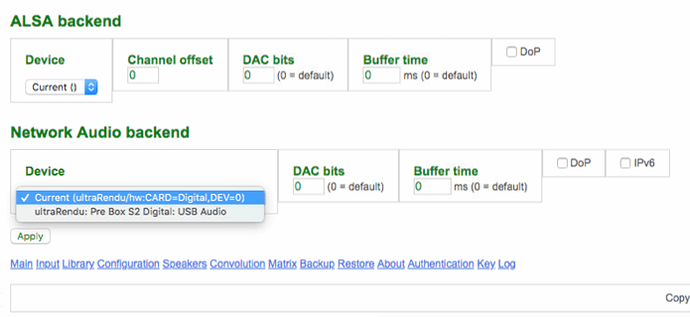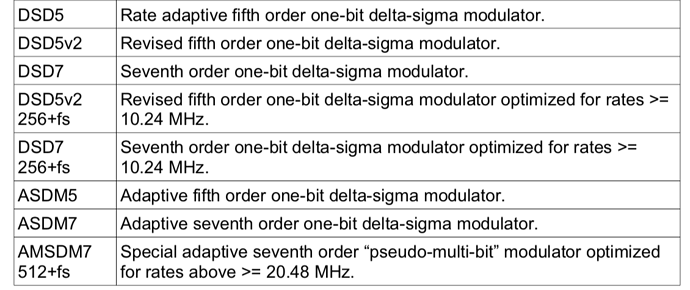It does look like there is plenty of CPU power to do this operation. I’ll ask @jussi_laako to take a look.
Ok thanks Gents
@jussi_laako is the DSD512+fs modulator expected to use more CPU than the ASDM7 modulator? Or is this an un-expected observation?
And is it normal to have to select the network backend device each cold boot? Or should it be remembering the last connected device?
Cheers
It uses somewhat more CPU, but not big difference. However you can happily stick to ASDM7 if the AMSDM7 is acting up for you.
It should connect to NAA at bootup, if the NAA and the DAC behind it are up and running at that time. If it cannot connect, you’ll be directed to /config page to select something that is available.
Now the NAA name and DAC device id are shown in parenthesis after the “Current”. You can check if those stay the same over time or if they change for some reason.
No problem, as mentioned ASDM7 has been working fine but if you are able to do something to help 512+fs working, it’s a nice bonus to be able to say ALL modulators and ALL 2s filters work at DSD512. I’m sure @agillis and Jesus would love to say that if it’s possible.
Anyway I’m sure you’ll look into it in the background - I’m just giving feedback. I appreciate all your help so far to get to this point.
And someone else in future will definitely try this 512+fs modulator and will definitely complain of pops, if they don’t read these threads. Another reason to make the problem go away (if it’s possible).
So far we’ve stuck only with ASDM7 since it’s working pop-free. I’ll start trying 256+fs modulator with DSD512 up-sampling and hear if that’s ok or has pops too…
As mentioned a few posts above 3 days ago, on every cold boot the ultraRendu name appears in the ‘current’ in brackets, but it doesn’t work. When you then click on the devices list, there is another ultraRendu that appears below ‘current’ and when you select that one and click apply, everything works again. And when everything works and you go back to the devices list, there is only one thing in the list and that is the current one.
This happens every cold boot, after being powered off.
See below which shows the device options on each cold boot:
Just by way of interest; fs means sampling frequency, so the +fs modulators just mean they are designed for that sampling rate and up. I say this to save other folk like me from fruitlessly searching the literature for something like “fantastic smoothness” or “factorial symmetry” that Jussi may have been adding to his modulators …
Cheers Andy, yes I posted a shot of the manual a few posts above, which mentions the >= also (greater than and equal to). The old man will be testing 256+fs modulator these next few days at DSD512 up-sampling.
It’s still my (current) favourite.
I’ll be visiting next weekend for mother’s day, so will get to play myself.
Really looking forward to it - as well as seeing mum of course 
Knowing the Pro-Ject S2 Digital, it looks like the connection failed for some reason at the time HQPlayer started. Maybe network wasn’t fully ready at that point, or something else prevented connection at startup. Because there don’t seem to be changes on NAA name or the audio device id.
ASDM5 and ASDM7 are adaptive in terms of sampling rate and also in other aspects (they auto-adjust parameters on fly). So they are as much optimized for 64fs and 256fs, etc.
AMSDM7 is happier higher the output rate is. It is quite complex and strange beast, so if you encounter any problems with it, go back to ASDM7 as a safe choice.
Since you mentioned the network not being ready, I remembered the S2 DAC and UltraRendu are each powered by Uptone LPS-1’s which take ~75 seconds to power up, on cold boot.
So his sonicT will be ready before his DAC and NAA, when all are powered on at the same time.
So today I asked him to boot up his DAC and NAA first, wait 2 minutes for the LPS-1’s to power them and THEN boot up the sonicT. And doing this sequence everything played immediately as you say it should. So that’s sorted.
The S2 DAC and network are fine. It’s just the NAA wasn’t ready when HQP Embedded was ready.
Noted, that’s the plan. Just to get a better understanding of what the sonicT i7 can and can’t do, I’ve asked the old man to leave the DSD7 256+fs modulator on for a few days with the xtr-2s filter and report how that goes.
DSD7 256+fs at DSD512 has been working pop free for days now, with the xtr-2s filters. So we/I’ve now got a good idea that with the xtr-2s filters at DSD512, it’s only the AMSDM7 DSD512+fs modulator that can be an issue.
So testing to see what the sonicT i7 can and can’t do with HQP (with RoonServer running on the same machine) is now over - dad’s over the testing and just wants to play with different filters. I gave him the all clear to proceed with enjoying the music.
Feedback from today, now that the testing shackles are off: he has very quickly gravitated to poly-sinc-short-mp-2s with DSD7 256+fs at DSD512 as his favourite.
He also says this is significantly better than Roon’s DSD512 up-sampling (any combination of Roon’s filter settings) in every way.
Over Team Viewer today I wiped RoPieee off his All DigiOne’s SD card and installed DietPi. I installed NAA (and RoonBridge, just in case) and showed him how to output audio from HQP Embedded to his DigiOne, to play to his living room system (Denon 4520 AVR).
He says poly-sinc-short-mp with NS9 at PCM192kHz is a really nice upgrade over Roon’s PCM up-sampling, with that system too.
Last year I was going to sell that i7 (I didn’t need it anymore) and let him keep the i5 that I’d bought him. But I thought, well maybe Roon will need the extra grunt one day, better to keep the i7 and sell the i5 instead.
Turned out to be a good idea keeping the i7 !
The sonicTransporter i7 + RoonServer + HQP Embedded is a really really neat package.
Very interesting. As you probably know this is a gentler sloped filter in the frequency domain and consequently one of the shortest in the time domain with no pre-ringing, minimal post ringing but phase varying with frequency. The modulator is aggressively apodising, shifting noise out of the audible band to well above the frequency cutoff of the filter, using the broad space created by DSD 512 upsampling. This all results in excellent transient response.
Does your Dad prefer the 2s variant for SQ reasons when upsampling to DSD 512 or because it’s got a shorter initialisation time ?
Nope he’s stuck with the 2s variant because I told him to (I’m new to HQP too).
I was concerned that ONLY the 2s variants work with DSD512. I skimmed through the bigger HQP threads and the common theme was 2s is easier on CPU loading, so I forced dad to stick with that - just initially, to get things working.
As per this thread, CPU loading has been a concern with RoonServer running on the same box.
We can try the non-2s poly-sinc-short-mp filter
Do you expect the non-2s poly-sinc-short-mp filter to have less CPU loading than the poly-sinc-xtr-2s filters? Or similar CPU loading?
I’m still learning so please do share thoughts and experiences.
The poly-sinc filters (including short) can have long initialisation times in their non-2s variants, but when they’re playing the CPU load is a bit less than xtr-2s. They’re front loaded somehow. Tell your Dad to put the kettle on while they’re initialising though. For a while I didn’t think they worked on my system, give them a minute or so.
Ha, fantastic. Will do this later today.
Let’s see how patient he is with the startup time.
@andybob it only took 5 seconds for music to start playing with the non-2s variant…
I told him to listen for pops and check CPU usage, while he’s enjoying the music of course.
CPU load looks higher and too many pops.
Maybe that’s where your CUDA helps you with your i7 server?
He’s getting fed up with all the (my) experimenting so I told him to stick with 2s.
I’ll naturally fiddle with it myself when I visit next weekend.
Andrew / Jussi
I just visited the folks this weekend (Mother’s Day surprise visit). And it turns out my old man’s phone feedback these past couple of weeks was not correct.
The pops are stil there at DSD512 , even with the 2s variant of poly-sinc-short-mp with ASDM7 modulator.
I tried to connect the sonicT i7 directly to the Pro-Ject S2 DAC vis USB and used ALSA backend (by-passing ultrarendu). But it wouldn’t accept DSD upsampling - it would just convert to PCM , even with output mode on SDM.
While we settled on DSD256 sounding great, for a new buyer I would probably recommend the i5 is enough for DSD256 upsampling - until I can see/hear DSD512 working pop free with the soncT i7.
Hopefully you guys can do some more testing. I know it’s stil just a new release and a work in progress.
I know DSD512 is working now for others using the i7. There may be a problem specific to your setup. We will continue to work with you until we can figure it out.

